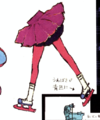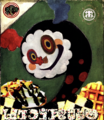Rebellion Production Note
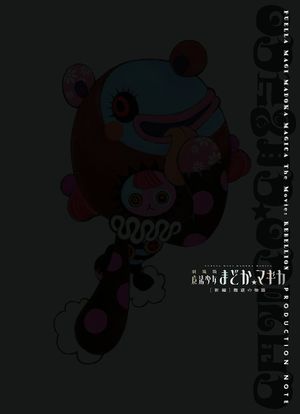
Puella Magi Madoka Magica The Movie: Rebellion Production Note is a set of two volumes that was first sold in a limited edition version at Comic Market 87 from December 28 to December 30, 2014. It became available to the general public starting February 28, 2015. Each set also comes with a bookmark magnifying glass.
The first volume is 277 pages long and contains:
- Character Design, page 005
- Prop Design, page 115
- Art Design, page 127
- Imageboard, page 197
- Special: Ume Aoki Original Character Designs, page 265
- Index, page 278
The second volume is titled Inu Curry Image Note 2 and contains 233 pages of illustrations and designs by Gekidan Inu Curry:
- Images, page 002
- Part A, page 036
- Part B, page 064
- Part C, page 094
- Part D, page 136
- Part E, page 166
See Rebellion/Synopsis for details on how the movie is divided into parts.
Translated pages
Image Note Page 081: Drosselmeyer's theater box
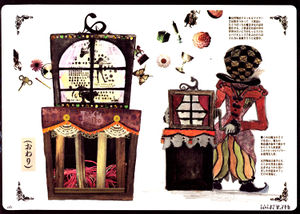
Using the theater box from the sideshow, Drosselmeyer tells the children the story of a lonely magical girl. The children, imagining the world in the story, fantasize about how wonderful it would be if the present were filled with more thrill and violence.
This is not a familiar of the witch. It's a mechanical doll operated by the witch's unconscious. This Drosselmeyer is a judge doll.
We thought about blending the sideshow into the background somewhere later in the second half, but in the end, it only appears in the café.
Bottom left: [The End]
Image Note Page 082 & 083: Clara Dolls

The Children of the False City - Initial Concept
The Children of the False City
- In a dome-shaped café, they watch a sideshow. All are girls.
- For character design, please make them appear around 6 years old in the world of Madoka. In the main story, no specific ages are set.
- Their faces are entirely obscured, and they are barefoot.
- From then on, they are sometimes seen riding a bus or blending into crowds. They exist discreetly, avoiding attention. (Mainly as silhouettes.)
- After the people of the city turn into paper dolls, the children also become flat and flimsy. They aren’t held by hand; instead, their heads turn into bookmarks (Discarded concept.)

- As suggested by their names, all of the children have bad personalities but get along well with each other.
- Their role is to cry during the funeral procession. They are mourners.
- Since the funeral is delayed in starting, they wander around, killing time.
Image Note Page 117

The image of the witch reflected in the water at Sayaka's feet and on her cape is an illusion created by Homura in response to the magic Sayaka is emitting. Since Homura only knows the old appearance of the Mermaid Witch, the reflected image uses the TV version’s design.
Image Note Page 123: Clara Dolls

Planned Appearances
● Early Stage
All characters are inside the café where Homura and Kyoko are having a conversation.
In other scenes, they wander around the city.
● Middle Stage 1
They appear in one of Homura's imagery scenes.
● Middle Stage 2
They are present when Homura transforms into a witch.
The cells in their eyes dissolve → they turn into paper dolls.
From then on, they appear as a symbol of Witch Homura's power.
● Middle Stage 3
They are at Homura's throne as paper dolls.
They chase Kyubey around as paper dolls.
● Late Stage 1
They appear during a battle, entering partway through as paper dolls.
They attack exclusively through blunt-force strikes and are incredibly strong.
During their battle with Sayaka and Kyoko, they disappear somewhere with the collapse of the barrier.
● Late Stage 2
Undetermined.
● Late Stage 3
In the altered world, the versions with cells in their eyes are seen wandering around.(Symbolically representing an ominous, unsettling presence.)
Homura is completely alone.
Image Note Page 124, 125 & 126: Clara Dolls

- When in paper doll form, the children carry knitting needles as weapons, all designed identically.
- The children’s personalities largely align with their names.
- They are dress-up dolls Homura used to play with.
- Even after Homura rewrote the world, the dolls continue to wander and play freely.
- The Children of the False City are less like the witch’s familiars and more akin to phenomena occurring within the False City. They are embodiments of the magic and karma that overflow from Homura.
- In the final draft, the children lack jawlines.
- For the versions with cells: they lack eyes, the noses aren't visible from the front, and their faces resemble lizards and are doll-like.
- All the faces are identical.

- When the witch’s familiars were designed to resemble Glasses Homura, their appearance during the battle with Sayaka and the others didn’t seem very intimidating. To enhance their presence, the café setting and part of the familiars' roles were reimagined into the Children of the False City, expanding their appearances.

- The children all get along well. Though not explicitly shown in the main story, Ibari & Nekura, Yakimochi & Namake, and Mie & Okubyou are often seen together.
- Reiketsu and Noroma have vacant stares. Noroma’s head is perpetually tilted.
Image Note Page 127: Clara Dolls
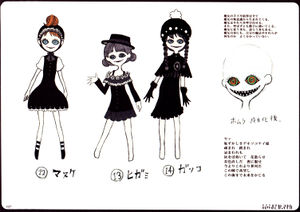
Top right:
All familiars and barriers are born from the witch’s unconscious.
The witch can summon them.
Also, they appear on their own without being called.
They may obey or disobey the witch.
Even the witch herself doesn’t fully understand her magic or the entities it creates.
Middle Right:
After Homura transforms into a witch*
Bottom right:
Yaa~
It's pitiful, shameful Mistress Failure.
Shunned, trampled,
And also despised.
Scatter ashes and strew flowers.
Change clothes, enter mourning.
From now, from here, let the funeral procession commence.
With these eyes, we gaze with envy.
And with these teeth, we gnaw at the future.
Image Note Page 128, 129, 130, 131 & 132: Clara Dolls





The Children of the False City - Animation Reference Materials
- When the witch's familiars attack humans:
① Types that have not received power from the witch → For "mealtime."
② Because they hate humans or for the witch’s sake.
③ Out of boredom. For entertainment.
④ Due to the nature of their roles, leading to humans dying as a result.
The Children of the False City fall under ③. Other familiars of the witch fall under ④ (The Nutcracker Witch's familiars).
- All the children have the same face (same doll design).
- Short Hair + Pants Look: Ibari's design is the easiest for animators to create, making it the most convenient for production.
- Usotsuki: One eye tends to be hidden. Aside from layered upper-body clothing, only she seems to have a feasible look.
- For the Children of the False City, their outfits aim for "cute but not very appealing to the opposite sex."
- When drawn normally, not as papercuts, the children disguise themselves as humans. Even magical girls struggle to distinguish them.
- Similar to other familiars of the witch, their way of thinking is instinctive and primal.
- They are always sneering at Failure.
- Furthermore, even when the Devil appears, they let out a big laugh.
- The children acknowledge the Devil as a top-tier comedian.
- Yakimochi's outfit has a "Mori Girl" style. Her mannerisms are also feminine.
- Because it’s difficult to differentiate between the witch’s familiars, this time we’ve given them code names such as 'Tooth Cavalry' and 'Kigurumi Bird.' All the children also have nicknames.
- During the dance inside the cupboard, only Noroma is slightly behind the others.
- Leaving the witch aside, for her familiars, the Law of Cycles is truly a nuisance because they are immediately sent to achieve enlightenment before being born.
- The Children of the False City like Madoka, but think the Law of Cycles is lacking. The Devil is okay. Only Manuke likes everyone.
- Although they take on a human form, their behavioral principles are completely different from human values, just like the other familiars.
- Ganko's brooch: the top part is metal, the rest is ribbon.
- The children love watching box plays at the floating café. Their absolute favorite play is 'The Pumpkin Who Ended Up All Alone Because of the Goddess.' The Mermaid Story isn't very popular.
- Recently, they have been obsessed with a game where they throw tomatoes at a pretentious person at just the right moment.
Image Note Page 133: Clara Dolls
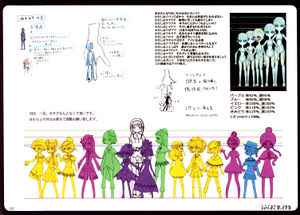
What is it that you lack?
I only ever behave arrogantly (Ibari). It's okay to act proud once in a while.
I'm Gloominess (Nekura), and even if you force yourself to smile, you just end up exhausted.
I'm Liar (Usotsuki). Is the truth always right?
I'm Coldheartedness (Reiketsu). Being too kind can be troublesome as well.
I'm Selfishness (Wagamama). Value your own feelings.
I'm Bad-mouth (Warukuchi). You quickly lock away your emotions.
I'm Slowpoke (Noroma). Not rushing too much is also important.
I feel nothing but Jealousy (Yakimochi). Jealousy is necessary for Love.
I'm the Lazy one (Namake). If you don't take a break, you'll turn into butter.
I'm such a Show-off (Mie). You also push yourself past your limits for someone's sake.
I'm Cowardice (Okubyou). But deeply cautious.
I'm Foolishness (Manuke). Even so, don't forget to be charming, too.
I'm only filled with Resentment (Higami). Let's change this unsatisfying reality.
I'm Stubborness (Ganko). Just don't forget the important stuff.
These bad habits are Love (Ai)'s allies.
Image Note Pages 142 & 143: Clara Dolls
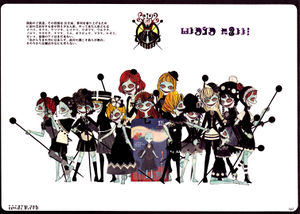
- See also: Witches Artwork
The Children of the False City. Their role is to be mourners. These dress-up dolls perform a play of tears in order to liven up the funeral procession. The dolls present are Arrogance, Gloominess, Liar, Coldheartedness, Selfishness, Bad-mouth, Slowpoke, Jealousy, Laziness, Show-off, Cowardice, Foolishness, Resentment, and Stubbornness, while the last one, Love, has yet to arrive. "Born from color, not in the sky, the edge of this mortal world is our stage.” Their power is no less than that of a magical girl.
- The first one to appear was Arrogance (Ibari). Stepping over Failure's head that tumbled across the bare earth, she bravely spoke on her behalf. “Cocky bastards. You shall not be forgiven. This feeling belongs to us alone.”
- The second one to come was Gloominess (Nekura). Sneaking forward, she sneered at Failure. “This is Failure. What an absolute disgrace.” These dolls are only disciples of freedom, and are loyal to their desires.
- The third one to come was Liar (Usotsuki). She put on a tearful performance dedicated to Failure's soul. “Pitiful Mistress Failure. That foolish soul is our pride.” These dolls sneer at the fool yet side with her.
- Following behind them is the fourth one, Coldheartedness (Reiketsu). She tripped over Failure's head, looking slightly irritated. “Why don't we cut Mistress Failure into smaller pieces to make her easier to carry around?” If the Devil speaks, these dolls will obediently follow.
- Further comes the fifth, Selfishness (Wagamama), walking angrily. “Hasn't the funeral procession started yet? I've been practicing how to cry as quickly as possible, you know? I can't wait any longer", she huffed. These dolls are someone and no one.
- Coming out with a look of annoyance is the sixth one, Bad-mouth (Warukuchi). As usual, she makes spiteful remarks. “Mistress Failure is quite the masterful comedian.” These dolls play house with utterly entangled karma.
- Finally arriving is the seventh, Slowpoke (Noroma). The silent doll laughs at the witch with her eyes. These dolls comply with the witch's wishes to a certain extent, unlike the diligent soldiers.
- The eighth to appear is Jealousy (Yakimochi). Entranced, she gazes at the sky. “Let's prepare a box. I want to keep that radiance locked away forever.” These dolls are a collection of colors (form). They don't belong to the sky (emptiness).
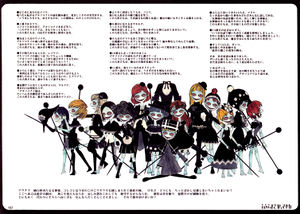
- The ninth one, Laziness (Namake), chats while yawning. “Do I have to go to the extent of helping with this children's play? Knitting is such a troublesome bother.” She kicked Failure's head, which was lying in her way. These dolls, with the funeral not starting at all, grow bored and wander aimlessly around the city.
- The tenth to come running is Show-off (Mie). She dramatically avoids Failure's head, saying, “I wouldn't be able to bear staining my cape with sticky blood.” These dolls mock the witch's self-harm.
- The eleventh one, trembling, is Cowardice (Okubyou). “If I am taken up into the sky, I won't even be able to behead the rabbit.” These dolls, with the power of magic, are able to achieve a complete recurrence.
- Walking unsteadily comes the twelfth one, Foolishness (Manuke). She goes out of her way to tell everyone what she just heard from a bird. “I heard a story about the Goddess. She's a beautiful and radiant goddess. I'm sure she will love us, too.” These dolls only desire what is within their reach.
- The thirteenth's footsteps are Resentment (Higami)'s. “Let's have a wonderful funeral like the one I heard in a story once. Let's bury lots of beautiful girls and cute animals together, too.” These dolls have power that rivals those of magical girls.
- Further comes the fourteenth, Stubbornness (Ganko). She points to the ground and rejects the sky. “The abyss of this mortal world is our stage.”
So, the mourners have gathered. Though it's become quite late, it's alright. The night is not yet over. The night will not be allowed to end anymore.
Right now is always
Before knowing that radiance. Before losing that radiance.
This is merely the prelude to the festival. The night before Failure.
All that's left is to wait for the funeral procession.
Now, now, pure-white, wondrously virtuous Goddess. Your nonchalant and deferential arrival, albeit belated, deeply moves us. But might you, perhaps, overlook just a little bit? Here stands the theater troupe of this mortal world. We are human, and this is simply human nature. Even if sorrow and resentment are destroyed, we despair nonetheless, as humans would. Passion drives our bones, and only melancholy washes through our guts. Anyway, instead, we can create plenty of others to turn toward your side, if that works for you. Wouldn’t that suffice for your forgiveness?
Image Note Page 152

- Small objects other than the bed: orange marigold flowers, ruler, yarn & knitting needles, syringe, IV stand, and socks.
The place where Witch Homura took refuge was Christmas inside the hospital room’s cabinet.
A time slightly before the moment she repeated over and over to save the Goddess.
A day from a slightly earlier life, a moment when she was happy.
A time when she didn’t even know what the Goddess looked like.
Had she remained ignorant like this, she might have stayed in a state where she neither saved anyone nor was saved.
Image Note Page 158

Kyubey is utterly despised by the witch and her familiars, but to the Children of the False City, the white animal is a convenient toy that never runs out no matter how much they play with it. Everyone is very impressed by its usefulness. Other living creatures dwindle if played with too much, so making them last as long as possible is quite a challenge.
Image Note Page 165

《The Nutcracker Witch》
Her nature is self-sufficiency.
This witch's karma produced an army of familiars on a scale that is difficult to comprehend under normal circumstances.
However, this witch is a half-formed failure.
Yet, if someone were to bestow unconditional love upon this ugly, broken doll; the heart of this wretched, half-formed witch might not remain lost forever.
Image Note Page 166

Initial Draft
Most witch labyrinths are composed of personal, single-minded, and inward-focused elements of the witch herself. The Nutcracker Witch's labyrinth is no exception, presenting a very narrow worldview. Her familiars are nothing but extensions of herself, evoking the image of a funeral procession taking place inside a house.
Image Note Page 172

Top text:
Right: Theatrical release
Bottom: Revised home video version
In the DVD & Blu-ray version, the number of ribbons around the witch's mouth has increased compared to the theatrical release.
Bottom text:
A magical girl’s mental state at the moment of her transformation is strongly reflected in the form of the witch she becomes.
The reason why the witch seen in the PSP game, the Witch of the Mortal World, and the Nutcracker Witch from Rebellion have different appearances is that the Witch of the Mortal World was born from a Homura who was unable to escape the one-month time loop.
Despair from yesterday is not necessarily the same as despair from today, so even for the same individual, different witches can be born depending on the time and circumstances.
Image Note Page 192

Witch Homura, while fighting Sayaka and the others to prevent her labyrinth from being destroyed, is also burdened with the troublesome desire of "wanting to be defeated here." To visually convey the sense of preventing her from committing suicide, we decided to place a massive guillotine platform.
Image Note Page 198
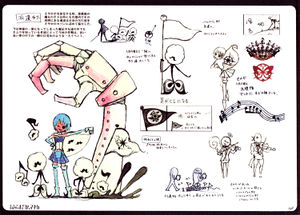
Dispatched familiars
When Sayaka materialized, the souls surrounding her within the Law of Cycles, in addition to the Rose Garden Witch's familiars, gathered fragments of themselves and placed them into Sayaka’s bag to assist her.
For the magical girls who have now become part of the Goddess, especially those who knew Homura, this operation was like a fleeting moment of awakening from a long, long dream—an extraordinary event.
Goddess Madoka's sigil: Slightly modified from the Witch of Salvation's crest from the PSP game.
Sayaka: After the Mermaid Witch's appearance, Goddess Madoka's mark appears on her cape.
Image Note Page 218
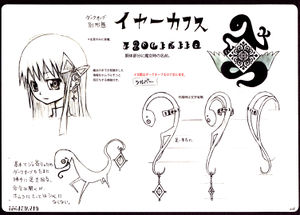
Upper right: Earcuff
HOMULILLY - The witch's name is written on the torso region.
Upper left: Dark orb
Alternate form (worn only on the left ear). Functions to whisper information seen and heard by the witch's familiars directly into Homura's ear.
Bottom left:
Due to its nature being close to that of a witch, the Dark Orb sometimes moves around on its own. It does follow orders, but for Homura, it can be troubling.
Image Note Page 219

Middle left:
Crown. Perfume bottle.
A pink light inside the center.
The top is spherical, the lid part of the bottle.
- Initially, the surface of the Dark Orb was planned to have intricate patterns, but for the sake of distinguishing it from the Soul Gem, it was ultimately made simple.
Bottom left:
Crest pattern. Monochrome.
Simplified crest.
Top right:
The mark of the Devil is a lizard that crawls on the ground. Since snakes have strong biblical imagery and lizards felt more human to us, we decided on a design of a lizard with upside down white wings. It is meant to look different from the sigil of the Law of Cycles and Western-style crests. It is not the mark of an evil being, but rather a symbol of a faith different from that of the Goddess worshipped by all.
- Early rejected designs for the Devil's crest
Observations
- Laziness' phrase on page 133 is a reference to Little Black Sambo. At one point in the story, Sambo, to appease three tigers trying to eat him, gives each of them his umbrella, shoes and clothing. Each tiger thinks they're the best looking one, and then chase each other around a tree. They run so quickly they melt into ghee (butter). Sambo's mother then uses the butter to make pancakes. This story is referenced briefly during the scene where Homura and Madoka are having tea at Mami's apartment, and Bebe becomes dazed. Three tigers circle around her head before a bubble with "Ghee" written in it appears and is followed by an image of pancakes.
Gallery
-
Black dress Homura art
-
Anthony art
-
Ulla art
-
Mathieu art
-
Gotz and Daniyyel & Jennifer art
-
An exhaustive explanation of Bebe speak
-
Bebe art
-
Art featuring Pyotr and Polina
-
Oktavia art
-
Art of Oktavia and Sayaka's orchestra in full
-
Art of Homulilly
-
Art of Lotte
-
Art featuring an unused design for Lotte which was used in the manga
-
Art of the Clara Dolls
-
Very early concept art for the Clara Dolls
-
Art of Liese
-
Art of Liese featuring an unused Homura styled Liese
-
Art of Luiselotte and Lilia
-
Art of Lilia. Her more detailed design was used in the manga
-
Art of Homulilly's labyrinth
-
Art of Lisa
-
Art which shows the Nightmare's appearance in reflections
-
Art of Hitomi's Nightmare and the first Nightmare
-
An unused Homura Nightmare
See also
External links
| Puella Magi Madoka Magica Supplementary Materials |
|---|
| Guidebooks |
| Guidebook "You Are Not Alone" ・ Guidebook "With You" ・ Guidebook "Only You" |
| Production & Image Notes |
| Puella Magi Production Note ・ Rebellion Production Note ・ Puella Magi Madoka Magica Art Book ・ Key Animation Note ・ Key Animation Note Rebellion ・ Rebellion Material Book |
| Rakugaki & Image Notes |
| Rakugaki Note ・ Rakugaki Note Rebellion |
| Other |
| Tiro Finale Book ・ Madogatari Exhibition Visual Book |
| Magia Record Supplementary Materials |
| Magia Archive |
| Magia Archive Volume 1 ・ Magia Archive Volume 2 ・ Magia Archive Volume 3 ・ Magia Archive Volume 4 |




